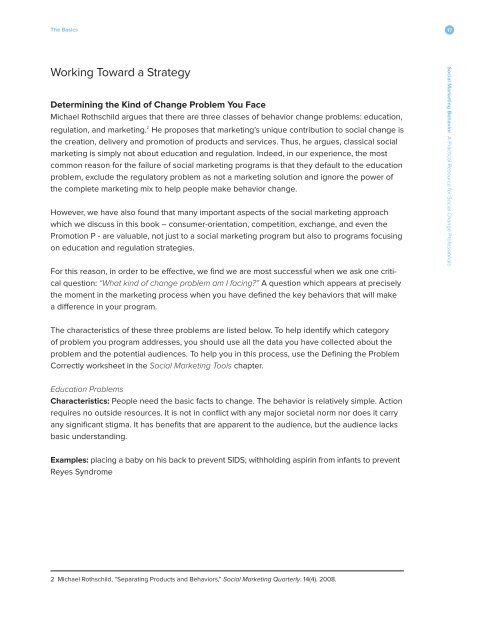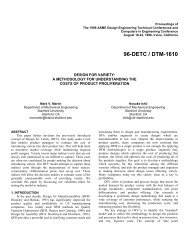Social Marketing
Create successful ePaper yourself
Turn your PDF publications into a flip-book with our unique Google optimized e-Paper software.
The Basics 17<br />
Working Toward a Strategy<br />
Determining the Kind of Change Problem You Face<br />
Michael Rothschild argues that there are three classes of behavior change problems: education,<br />
regulation, and marketing. 2 He proposes that marketing’s unique contribution to social change is<br />
the creation, delivery and promotion of products and services. Thus, he argues, classical social<br />
marketing is simply not about education and regulation. Indeed, in our experience, the most<br />
common reason for the failure of social marketing programs is that they default to the education<br />
problem, exclude the regulatory problem as not a marketing solution and ignore the power of<br />
the complete marketing mix to help people make behavior change.<br />
However, we have also found that many important aspects of the social marketing approach<br />
which we discuss in this book – consumer-orientation, competition, exchange, and even the<br />
Promotion P - are valuable, not just to a social marketing program but also to programs focusing<br />
on education and regulation strategies.<br />
For this reason, in order to be effective, we find we are most successful when we ask one critical<br />
question: “What kind of change problem am I facing?” A question which appears at precisely<br />
the moment in the marketing process when you have defined the key behaviors that will make<br />
a difference in your program.<br />
The characteristics of these three problems are listed below. To help identify which category<br />
of problem you program addresses, you should use all the data you have collected about the<br />
problem and the potential audiences. To help you in this process, use the Defining the Problem<br />
Correctly worksheet in the <strong>Social</strong> <strong>Marketing</strong> Tools chapter.<br />
Education Problems<br />
Characteristics: People need the basic facts to change. The behavior is relatively simple. Action<br />
requires no outside resources. It is not in conflict with any major societal norm nor does it carry<br />
any significant stigma. It has benefits that are apparent to the audience, but the audience lacks<br />
basic understanding.<br />
Examples: placing a baby on his back to prevent SIDS; withholding aspirin from infants to prevent<br />
Reyes Syndrome<br />
2 Michael Rothschild, “Separating Products and Behaviors,” <strong>Social</strong> <strong>Marketing</strong> Quarterly. 14(4). 2008.<br />
<strong>Social</strong> <strong>Marketing</strong> Behavior A Practical Resource for <strong>Social</strong> Change Professionals

















